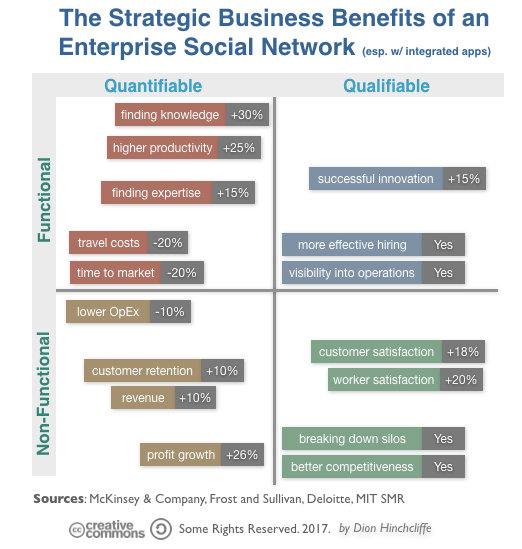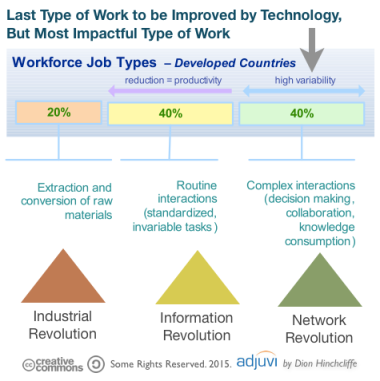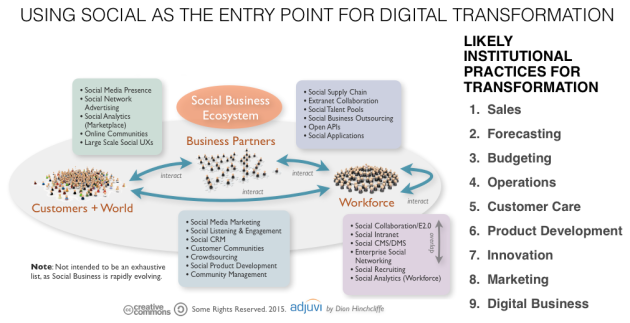The Strategic Value of Social Business: What We’ve Learned
February 5, 2015 2 Comments
Recently, I had the need to gather our latest research from research, clients, and case studies on the established performance of social business for the Future of Work master class I delivered in Paris at Enterprise 2.0 SUMMIT 2015 this week.
The intent was to answer this question: What specifically is the business value in social-based ways of working today and tomorrow?
By this, I largely mean the design and deployment of enterprise social networks to create better business outcomes. The typical range of benefits can be ascribed to the effective use of newer types of situated collaboration tools that have a social layer, especially digital workplace environments that:
a) make the information that’s shared public by default and;
b) leave a permanent record of collaboration that is open to everyone for learning, analysis, and reuse.
These two attributes remain the critical difference between older generations of collaboration and communication tools in terms of providing differentiating results. While point-to-point collaboration methods have utility, they simply don’t have the strategic, long-term benefits of social-based approaches.
From this survey, I determined we can put the results into three primary classes of benefits:
Tactical improvements to existing ways of working
It’s clear from looking at the meta-studies of all recent measures of performance benefits to improving existing business processes by working through social network that significant results are to be had. Last year I assembled our latest such synthesis of results. It confirmed the consistent low double-digit business-wide returns that are likely if you employ the capabilities in the way that employees broadly work. These fall into a variety of categories that are both qualitative and quantitative: Finding needed information faster, lowering operational expenditures, higher customer satisfaction/retention, increased productivity, more successful innovation, and reduced travel/communications costs.

It should be noted that while these improvements are typically in the lower double-digits — and can often form the core business case of an social business initiatives on its own — they are incremental and don’t describe the fundamental digital transformation of the enterprise. Though I noted here at Enterprise 2.0 SUMMIT this week that they can provide the entry point for such large-scale changes, these are the in-place improvements of existing processes that you get initially from getting the workforce connected better and sharing information more frequently and with less friction.
Supporting tacit interactions: Complex, highly variable problem solving
The next major areas where social tools provide strategic value is by aiming them at the last significant area where existing aids have left little mark. This is the area of knowledge work where the work is far from routine, consists of highly creative and/or analytic problem solving, is highly variable, may change its fundamental nature frequently, and is what today’s highest leverage workers adapt to and engage in to get their jobs done.
Historically, important economic activities such as farming (which was largely replaced by machines), and mental labor like accounting (again replaced by computers and spreadsheets) were supplanted by tools that had more capacity and far lessor cost. While today is increasingly the concern that everything humans will do might be replaced by robots, for this category of social business improvements, we’re largely referring to aids to humans for complex collaborative team work, and have long-resisted attempts at automation.
With today’s workplace AI tools, increasingly good access to a rich tapestry of contextual business data from employees working out loud, and situated solutions like decision aids or IBM’s Watson, today’s most valuable group of workers actually has a chance to significant improve the most strategic and high-impact 40% of work currently taking place.
Re-imagining institutional practices: Fundamentally rethinking business
The last category of benefits comes when companies have largely succeeded in networking their workers, often 3-5 years after their initial social networking efforts. Once an organization has a strong social foundation and workers generally are using the new platforms — in particularly understanding and using the powerful capabilities inherent in their design — then organizations are ready to begin the real work of digital transformation, at least internally (though it of course, has many external implications as well.)
This can mean everything from opening up forecasting and budgeting to be more participative and transparent to building collaborative communities for customer care between customers and the workforce, or even (or perhaps especially) just between customers. Whatever it means, it means taking a brand new look at the possibilities in terms of what networked ways of working makes possible, especially letting the network do the work, for example. The key here is that this third class of benefits is a highly strategic activity that doesn’t merely improve existing processes but rethinks them for the possibilities of the network era. Engaging in this activity at some point is critical for pushing the organization into the future, making it sustainable, and should be structured as a capability that is more or less continuous within the organization as digital change continues to unfold.
The business case for digital progress
I am asked frequently about being able to paint a clear picture of why there is an imperative for organizations to essentially disrupt what they’re already doing today, even though more or less successfully, and invest in new ways of working. I believe this framework is a good start in articulating this.
Using this lens, these three categories offer an increasingly strategic planes of improvement that companies can understand as they proceed through the journey of becoming a true digital/social business. This should provide a useful map that understand how to map value to the maturity of the journey that your organization has undergone thus far.
Update: Adding the 25% overall productivity stat for enterprise social networks from MIT-SMR.
Additional Reading
Digital Priorities for the C-Suite in 2015
The Role of the CIO in Digital and Social Business Transformation
How Leaders Can Address the Challenges of Digital Transformation





























































Pingback: How Online Communities Became Vital to Managing Partner Relationships | 7Summits
Pingback: Using Online Communities to Improve Field Enablement | 7Summits